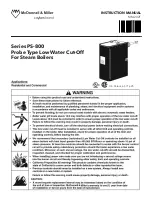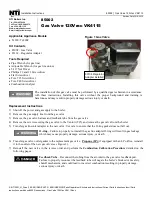
DIVACONDENS F D
53
EN
cod. 3541N242 - Rev. 02 - 04/2018
DHW temperature adjustment
Use the DHW buttons (details 1 and 2 - fig. 1) to adjust the temperature from a min. of
40°C to a max. of 55°C.
fig. 5
Room temperature adjustment (with optional room thermostat)
Using the room thermostat, set the temperature required in the rooms. If the room ther-
mostat is not installed, the boiler will keep the system at the set system delivery setpoint
temperature.
Room temperature adjustment (with optional remote timer control)
Using the remote timer control, set the required temperature in the rooms. The boiler will
adjust the system water according to the required room temperature. For operation with
remote timer control, please refer to the relevant instruction manual.
ECO/COMFORT selection
The unit has a function that ensures a high domestic hot water delivery speed and max-
imum comfort for the user. When the device is activated (COMFORT mode), the water
contained in the boiler is kept hot, thereby ensuring immediate availability of hot water
on opening the tap, without waiting times.
The user can deactivate the device (ECO mode) by pressing the
eco/comfort
button
(detail 7 - fig. 1). In ECO mode the display activates the ECO symbol (detail 12 - fig. 1).
To activate the COMFORT mode, press the
eco/comfort
button (detail 7 - fig. 1) again.
Sliding Temperature
When the optional external probe is installed the boiler adjustment system works with
"Sliding Temperature". In this mode, the heating system temperature is regulated ac-
cording to weather conditions, to ensure the high comfort and energy efficiency through-
out the year. In particular, as the outside temperature increases the system delivery
temperature decreases according to a specific "compensation curve".
With the Sliding Temperature adjustment, the temperature set with the heating buttons
(detail 3 - fig. 1) becomes the maximum system delivery temperature. It is advisable to
set a maximum value to allow system adjustment throughout its useful operating range.
The boiler must be adjusted at the time of installation by qualified personnel. However,
the user can make any further adjustments necessary to optimise comfort levels.
Compensation curve and curve offset
Press the
reset button
(detail 6 - fig. 1) for 5 seconds to access the “Sliding temperature”
menu; the display shows “CU” flashing.
Use the DHW buttons (detail 1 - fig. 1) to adjust the desired curve from 1 to 10 according
to the characteristic (fig. 6). By setting the curve to 0, the sliding temperature adjustment
is disabled.
Press the heating buttons (detail 3 - fig. 1) to access parallel curve offset; the display
shows “OF” flashing. Use the DHW buttons (detail 1 - fig. 1) to adjust parallel curve offset
according to the characteristic (fig. 7).
Press the
reset button
(detail 6 - fig. 1) again for 5 seconds to exit the "Sliding Temper-
ature" menu.
If the room temperature is lower than the required value, it is advisable to set a higher
order curve and vice versa. Proceed by increasing or decreasing in steps of one and
check the result in the room.
fig. 6 - Compensation curves
fig. 7 - Example of compensation parallel curve offset
Adjustments from Remote Timer Control
A
If the Remote Timer Control (optional) is connected to the boiler, the above ad-
justments are managed according to that given in table 1.
Table. 1
System water pressure adjustment
The filling pressure read on the boiler water gauge (detail 2 - fig. 8) with system cold must
be approx 1.0 bar. If the system pressure falls below minimum values, the boiler stops
and fault
F37
is displayed. Pull out the filling knob (detail 1 - fig. 8) and turn it anticlock-
wise to return it to the initial value. Always close it afterwards.
Once the system pressure is restored, the boiler will activate the 300-second air venting
cycle indicated on the display by
Fh
.
To prevent boiler shutdown, it is advisable to periodically check the pressure on the
gauge with system cold. In case of a pressure below 0.8 bar, it is advisable to restore it.
fig. 8- Filling knob
System draining
The drain faucet ring nut is located under the safety valve inside the boiler.
To drain the system, turn the ring (ref. 1 - fig. 9) counter-clockwise to open the faucet. Do
not use any tools; use hands only.
To drain only the water in the boiler, first close the shut-off valves between the system
and boiler before turning the ring.
fig. 9- Safety valve with drain faucet
I I I I
II
II
I
20
30
40
50
60
70
80
90
85
20
10
0
-10
-20
1
2
3
4
5
6
8
9
10
7
20
30
40
50
60
70
80
90
85
20
30
40
50
60
70
80
90
85
1
2
3
4
5
6
8
9
10
7
1
2
3
4
5
6
8
9
10
7
OFFSET = 20
OFFSET = 40
Heating temperature setting
Adjustment can be made from the Remote Timer Control menu
and the boiler control panel.
DHW temperature adjustment
Adjustment can be made from the Remote Timer Control menu
and the boiler control panel.
Summer/Winter Switchover
Summer mode has priority over a possible Remote Timer Control
heating demand.
Eco/Comfort selection
On disabling DHW from the Remote Timer Control menu, the
boiler selects the Economy mode. In this condition, the
eco/com-
fort
button (detail 7 - fig. 1) on the boiler panel is disabled.
On enabling DHW from the Remote Timer Control menu, the
boiler selects the Comfort mode. In this condition it is possible
select one of the two modes with the
eco/comfort
button (detail 7
- fig. 1) on the boiler panel.
Sliding Temperature
Both the Remote Timer Control and the boiler card manage Slid-
ing Temperature adjustment: the boiler card Sliding Temperature
has priority.
A
B
1
1
2
1
















































